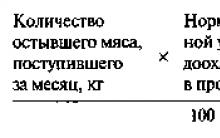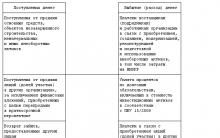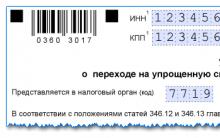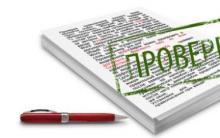The initial cost of the OS. There was a following question. Are these expenses taken into account at cost or as other expenses not for tax purposes?
According to PBU 10/99, the costs of ordinary species activities form: the costs associated with the acquisition of raw materials, materials, goods and other inventories; expenses arising directly in the process of processing (refining) inventories for the purposes of manufacturing products, performing work and providing services and selling them, as well as selling (reselling) goods (expenses for the maintenance and operation of fixed assets and other non-current assets, as well as maintaining them in good condition, selling expenses, management expenses, etc.). When forming expenses for ordinary activities, they should be grouped according to the following elements: material costs;
labor costs; deductions for social needs; depreciation; other costs.
For the purposes of formation by the organization financial result activities from ordinary activities, the cost of goods sold, products, works, services is determined, which is formed on the basis of expenses for ordinary activities recognized as reporting year as well as in previous reporting periods. Thus, you must include these costs in other costs, which will ultimately form the cost of manufactured products.
The rationale for this position is given below in the document, which you can find in the “Legal base” tab of the “Glavbukh Systems” version for commercial organizations
ORDER, PBU OF THE MINISTRY OF FINANCE OF RUSSIA DATED 06.05.1999 No. 33N, PBU10/99
7. Expenses for ordinary activities form:
expenses associated with the acquisition of raw materials, materials, goods and other inventories;
expenses arising directly in the process of processing (refining) inventories for the purposes of manufacturing products, performing work and providing services and selling them, as well as selling (reselling) goods (expenses for the maintenance and operation of fixed assets and other non-current assets, as well as maintaining them in good condition, selling expenses, management expenses, etc.).
8. When forming expenses for ordinary activities, their grouping according to the following elements should be ensured:
material costs;
labor costs;
deductions for social needs;
depreciation;
other costs.
For the purposes of management in accounting, accounting of expenses by cost items is organized. The list of cost items is established by the organization independently.
9. For the purposes of formation by the organization of the financial result of activities from ordinary activities, the cost of goods sold, products, works, services is determined, which is formed on the basis of expenses for ordinary activities recognized both in the reporting year and in previous reporting periods, and passing expenses related to the receipt of income in subsequent reporting periods, taking into account adjustments depending on the specifics of the production of products, the performance of work and the provision of services and their sale, as well as the sale (resale) of goods.*
1. Material costs: raw materials, materials, purchased components and semi-finished products, fuel, electricity, heat, etc.2. Labor costs 3. The cost of deductions for social needs4. Depreciation
5. Other costs ( rent, interest on bank loans, taxes, etc.)
Classification on primary economic elements allows you to develop a cost estimate for production, which determines: the total need for material resources; sum depreciation charges fixed assets; labor costs; other cash expenses of the enterprise.
Other expenses include:
Associated with the provision for a fee for temporary use of the company's assets;
Associated with the granting for a fee of rights arising from patents for inventions and other types of intellectual property;
Associated with participation in authorized capitals other organizations;
Related to the sale, disposal and write-off of fixed assets and other assets;
Interest paid by the company for received credits and loans;
Contributions to estimated reserves(for doubtful debts, for depreciation of investments in securities) and etc.
The mechanism for generating financial results from the sale finished products(works, services). Characteristics of account 90 "Sales".
Organizations receive the bulk of their profits from the sale of products, goods, works and services (realization financial result). Profit from the sale of products (works, services) is defined as the difference between the proceeds from the sale of products (works, services) at current prices, excluding VAT and excises, export duties and other deductions provided for by law Russian Federation, and the costs of its production and sale.
The financial result from the sale of products (works, services) is determined by account 90 "Sales". This account is intended to summarize information on income and expenses associated with the ordinary activities of the organization, as well as to determine the financial result for them.
The main features of the 90 account are the following:
It is closed not at the end of each quarter, but at the end of the year when the balance sheet is reformed;
The debit of the account reflects all costs, the credit - all income (revenue).
This account reflects, in particular, the revenue and cost of:
Finished products, semi-finished products of own production and goods;
Works and services of an industrial and non-industrial nature;
Construction, installation, design and survey, research, etc. work;
Communication services and transportation of goods and passengers;
Forwarding and loading and unloading operations;
Provision for a fee for temporary use (temporary possession and use) of their assets under a lease agreement, provision for a fee of rights arising from patents for inventions, industrial designs and other types of intellectual property, participation in the authorized capital of other organizations (when this is the subject of the organization’s activities ) etc.
The amount of proceeds from the sale of products, goods, performance of work, provision of services, etc. is reflected in the credit of account 90 "Sales" and the debit of account 62 "Settlements with buyers and customers". At the same time, the cost of sold products, goods, works, services, etc. is debited from the credit of accounts 43 "Finished products", 41 "Goods", 44 "Sales expenses", 20 "Main production", etc. to the debit of account 90 "Sales" .
In the debit of account 90, the actual cost of production is written off from the credit of the accounts for accounting for the costs of production. In those industries where the actual cost of production is determined at the end of the year (plant growing, etc.), the planned cost of production is written off on account 90 during the year. At the end of the year, determine the deviation actual cost products from the planned and the identified deviation are written off to the debit of account 90 from the credit of the accounts for accounting for the costs of production.
In organizations that carry out retail and keeping records of goods at sale prices, the credit of account 90 "Sales" reflects the sale value of goods sold (in correspondence with accounting accounts Money and settlements), and for debit - their book value(in correspondence with account 41 "Goods") with simultaneous reversal of the amounts of discounts (markups) related to the sold goods (in correspondence with account 42 "Trade margin").
To account 90 "Sales" sub-accounts can be opened:
90-1 "Revenue";
90-2 "Cost of sales";
90-3 "Value Added Tax";
90-4 "Excises";
90-9 "Profit/loss on sales".
On sub-accounts 90-1, 90-2, 90-3, 90-4, respectively, received proceeds from the sale of products, the cost of products sold, accrued VAT and excises are taken into account.
Organizations - payers of export duties can open a sub-account 90-5 "Export duties" to account 90 to record export duties.
Sub-account 90-9 "Profit / loss from sales" is intended to identify the financial result from sales for the reporting month.
Entries on sub-accounts 90-1, 90-2, 90-3, 90-4, 90-5 are made accumulatively during the reporting year. On a monthly basis, by comparing the total debit turnover on subaccounts 90-2, 90-3, 90-4, 90-5 and the credit turnover on subaccount 90-1, the financial result from sales for the reporting month is determined. The revealed profit or loss is deducted from sub-account 90-9 to account 99 "Profits and losses" monthly by final entries. Thus, the synthetic accounting of account 90 "Sales" is closed monthly and has no balance on the reporting date.
At the end of the reporting year, all sub-accounts opened to account 90 "Sales" (except for sub-account 90-9) are closed by internal entries to sub-account 90-9 "Sales profit/loss".
Analytical accounting on account 90 "Sales" is carried out for each type of product sold, goods, work performed and services rendered, and, if necessary, in other areas (by sales regions, etc.).
Expenses for ordinary activities are the costs associated with the manufacture and sale of products, the purchase and sale of goods. They also include expenses, the implementation of which is associated with the performance of work, the provision of services.
For such types of activities as the lease of property, the provision for a fee of rights arising from patents for inventions, industrial designs and other types of intellectual property and participation in the authorized capital of other organizations, the rules for their accounting as expenses for ordinary activities or other expenses are given. The organization independently, for accounting purposes, establishes where to attribute them, depending on the areas of activity, the nature of the costs, the size and conditions of implementation.
PBU 10/99 contains one deviation from the definition of the concept of expenses. Compensation for the cost of fixed assets, intangible assets and other depreciable assets of the organization, carried out in the form of depreciation deductions.
Expenses for ordinary activities are divided into two parts:
- expenses associated with the acquisition of raw materials, materials, goods and other inventories; - expenses arising directly in the process of processing (refinement) of inventories for the purposes of manufacturing products, performing work and rendering services and their sale, as well as the sale of goods. These are expenses for the maintenance and operation of fixed assets and other non-current assets, as well as for maintaining them in good condition, commercial expenses, management expenses, etc.
When forming expenses for ordinary activities, they should be grouped according to the following elements:
1) material costs;
2) labor costs;
3) deductions for social needs;
4) depreciation;
5) other expenses.
For the purposes of management in accounting, accounting of expenses by cost items is organized. The list of cost items is established by the organization independently in the accounting policy.
In accordance with PBU 10/99, commercial and administrative expenses may be recognized in the cost of sold products, goods, works, services in full in the reporting year of their recognition as expenses for ordinary activities. That is, these expenses, accounted for on accounts 26 “General expenses” and 44 “Sales expenses”, can be debited to the debit of account 90 “Sales” on a monthly basis.
If in the reporting period the company did not earn anything, but incurred management expenses, write them off from account 26 "General expenses" to account 20 "Main production". After all, this account is also closed, and the balance on it shows the value of work in progress. In the absence of such, its assessment cannot be reflected.
To debit 90 accounts general running costs also cannot be written off. Indeed, in the absence of sales proceeds (income from ordinary activities), the cost of sales cannot be formed.
Therefore, general business expenses can be written off to other expenses not related to production and sales - to account 91 "Other income and expenses" or included in the losses of the organization - in the debit of account 99 "Profits and losses".
Expenses for ordinary activities are taken to accounting in an amount calculated in monetary terms equal to the amount of payment in cash and in other form or amount accounts payable.
If the payment covers only a part of the recognized expenses, then the expenses accepted for accounting are determined as the sum of the payment and accounts payable (in the part not covered by the payment).
Expenses for ordinary activities are expenses associated with the manufacture and sale of products, the purchase and sale of goods. Such expenses are also considered expenses, the implementation of which is associated with the performance of work or the provision of services.
Expenses for ordinary activities include expenses associated with the provision for a fee for temporary use under a lease agreement of one's assets, including intangible ones; expenses associated with participation in the authorized capital of other organizations, if these types of activities are the main ones for organizations.
Expenses for ordinary activities are also considered to be the reimbursement of the cost of fixed assets, intangible assets and other depreciable assets carried out in the form of depreciation deductions.
Expenses for ordinary activities are accepted for accounting in an amount calculated in monetary terms, equal to the amount of payment in cash and in other form or the amount of accounts payable.
If the payment covers only part of the recognized expenses, then the expenses accepted for accounting are determined as the amount of payment and the amount of outstanding accounts payable.
The amount of payment is determined based on the price and conditions established by the contract between the organization and the supplier, taking into account all discounts and capes. If the price is not provided for in the contract and cannot be established based on the terms of the contract, then the price at which, in comparable circumstances, the organization usually determines the costs in relation to similar inventories, valuables, works, services or the provision of similar assets for temporary use is accepted.
When paying for the acquired values, works, services on the terms of a commercial loan provided in the form of an installment payment, the expenses are accepted for accounting together with the amount of accrued interest.
Expenses for ordinary activities form the costs:
- - associated with the acquisition of raw materials, materials, goods and other inventories;
- - arising directly in the process of processing inventories for the purposes of manufacturing products, performing work and providing services and selling them, as well as selling goods, expenses for the maintenance and operation of fixed assets and other non-current assets, as well as for maintaining them in good condition, commercial expenses, management expenses, etc.
When forming expenses for ordinary activities, they should be grouped according to the following elements:
- - material costs;
- - labor costs;
- - deductions for social needs;
- - depreciation;
- - other expenses.
For the purposes of management and control in accounting, it is necessary to organize the accounting of expenses by cost items. The list of cost items is established by the organization independently, taking into account industry specifics.
In fact, the costs of ordinary activities are the costs of forming the cost price. Therefore, initially they are reflected in the relevant accounting accounts (salary - on account 70 "Settlements with personnel for wages", depreciation - on account 02 "Depreciation of fixed assets", etc.). At the end of the reporting period, these expenses are transferred to the debit of account 90 "Sales", as they ultimately lead to income in the form of revenue, reflected in the credit of the same account 90 "Sales".
In order for the amount of expense to be recognized in accounting, the following conditions must be met:
- - the expense is made in accordance with a specific contract, the requirements of legislative and regulatory acts, business practices;
- - the amount of the expense can be determined;
- - there is confidence that as a result of a particular operation there will be a decrease in the economic benefits of the organization. Such assurance exists when the entity has transferred the asset or there is no uncertainty about the transfer of the asset.
If at least one of the above conditions is not met in relation to any expenses incurred by the organization, then the organization’s accounting records receivables.
Depreciation is recognized as an expense based on the amount of depreciation deductions determined on the basis of the cost of depreciable assets, the period beneficial use and methods of depreciation accepted by the organization.
In accordance with the principle of temporal certainty of facts economic activity(accrual) expenses are recognized in the reporting period in which they occurred, regardless of the time of actual payment of funds or other form of implementation. If the organization has adopted the procedure for recognizing revenue from the sale of products and goods, work performed or services rendered after the receipt of cash and other forms of payment, then expenses are recognized after the debt is repaid.
Expenses for ordinary activities are expenses associated with the manufacture and sale of products, the purchase and sale of goods, the provision of services or the performance of work, i.e. carrying out the activities for the purpose of which the economic entity (organization, enterprise) was created.
In those organizations whose subject of activity is the lease of their assets, participation in the capital of other organizations, as well as the provision for a fee of rights arising from patents for inventions, industrial designs, and other intellectual property, these operations are ordinary activities.
Expenses for ordinary activities are accepted for accounting in an amount equal to the amount of payment in cash (other form) or the amount of accounts payable.
Expenses for ordinary activities form expenses:
* associated with the consumption of raw materials, materials, fuel and other production stocks;
arising directly in the process of processing inventories or production of products (performance of work, provision of services);
related to the management of the organization as a whole;
associated with the sale of the finished product of the manufacturing process.
It should be noted that the assignment of amounts to expenses for ordinary activities or to other expenses is conditional, their lists are open and the organization itself decides which group to attribute certain expenses to, since this does not affect the value of the final financial result.
All expenses of the organization are recognized in accounting under the following conditions:
the amount of expenses can be determined;
there is confidence that as a result of a particular transaction there will be a decrease in the economic benefits of the organization.
If at least one of the above conditions is not met in relation to the expenses incurred by the organization, then not expenses are recognized in accounting, but receivables.
A prerequisite for the recognition of expenses is their assignment to a specific accounting period. Expenses are recognized in the reporting period in which they are incurred, regardless of the time of actual payment of funds.
Expenses are classified depending on the purposes of accounting: to determine the cost of manufactured products and form the financial result of the activity; for the implementation of current control; for making managerial decisions. Consider the main features of the classification of expenses.
By economic content expenses are subdivided into expenses according to economic elements and expense items (calculation items). Typically, an economic element is a homogeneous type of expenditure. The division of costs by economic elements allows you to determine the types of costs for the organization as a whole, regardless of their place of origin and direction.
An expense item, or costing item, is usually called a certain type of cost that forms the cost as certain types products (works, services), and the entire output of the organization. The composition of costing items is currently not regulated, but, based on established practice, it is possible to offer their approximate nomenclature:
raw materials and materials;
returnable waste (subtracted, as they reduce the spent raw materials and materials);
purchased products, semi-finished products and services of an industrial nature of third-party organizations;
fuel and energy for technological purposes;
wage production workers;
expenses for the preparation and development of production;
overhead costs;
general business expenses (administrative expenses);
losses from marriage;
other production expenses.
Total: production cost of production, selling expenses.
TOTAL: total cost of production.
Depending on the methods of inclusion in the cost of products (works, services), costs can be divided into direct and indirect.
Direct costs are associated with the production of a certain type of product and can be directly (based on information primary documents) and directly related to its cost. These include most often the costs of raw materials, purchased semi-finished products, fuel and energy for technological purposes, wages of production workers.
Indirect costs include the costs associated with the production of several types of products, the performance of several types of work simultaneously. Such costs can be distributed between the cost of each type of product (work, service) only on the basis of special calculations. But any indirect distribution of costs leads to inaccuracies in determining the cost, therefore, when organizing accounting, it is necessary to organize analytical accounting in such a way as to minimize specific gravity indirect costs.
For income tax purposes, expenses can be divided into limited and non-limited. Limitable expenses include such expenses for which limits, norms and standards are established by law. Such expenses include compensation for the use of personal cars for business trips, travel and hospitality expenses, tuition fees under contracts with educational institutions for training and retraining of personnel, advanced training, expenses for paying interest on loans "advertising expenses. Unlimited expenses include expenses taken in actual size.
Depending on the frequency of occurrence, all expenses can be divided into current and one-time. Current costs include the costs associated with the production and sale of products of this period. This is usually the bulk of an organization's expenses. Non-recurring expenses are those associated with the preparation of new industries, the development of new products, the reservation of expenses for any purpose (payment for vacations, repair of fixed assets, etc.).
According to their composition, all expenses are divided into single-element and complex. Single-element expenses are called expenses consisting of a homogeneous type of expenses (for example, the costs of raw materials and materials, wages of production workers, etc.). Complex - consist of several types of expenses. For example, the composition of such complex expenses as general business expenses includes the cost of materials for general business purposes, wages of the organization's management, depreciation of buildings, etc.
According to the expediency of spending, all expenses can be divided into productive and unproductive. Production includes all costs that are necessary and planned (forecasted) for this production. Unproductive expenses include expenses that are formed for reasons that indicate deviations from the normal production technology (defective products, losses from downtime, overtime pay, etc.).
According to participation in the production process, all costs are divided into production and commercial (non-production). Production includes all expenses of the organization associated with the manufacture of finished products, the performance of work and the provision of services and are included in their cost. Commercial (non-production) refers to the costs associated with the sale of products to consumers.
Accounting regulation "Expenses of the organization" PBU 10/99 establishes a unified nomenclature of economic elements of expenses for ordinary activities for all organizations:
material costs (minus the cost of returnable waste);
labor costs;
deductions for social needs;
depreciation;
other costs.
Expenses are recognized in accounting under the following conditions:
the expense is made in accordance with a specific contract, the requirement of legislative and regulatory acts, business customs;
the amount of the expense can be determined;
there is confidence that as a result of a particular transaction there will be a decrease in the economic benefits of the organization. There is certainty that a particular transaction will reduce the entity's economic benefits when the entity has transferred the asset, or there is no uncertainty about the transfer of the asset.
If at least one of the named conditions is not fulfilled in relation to any expenses incurred by the organization, then the organization's accounting records recognize receivables. Depreciation is recognized as an expense based on the depreciation expense based on the value of the depreciable assets, their useful lives and the entity's depreciation methods.
Expenses are subject to recognition in accounting, regardless of the intention to receive revenue, operating or other income and from the form of the expenditure (cash, in kind and other).
Expenses are recognized in the reporting period in which they occurred, regardless of the time of actual payment of funds and other form of implementation (assuming the temporal certainty of the facts of economic activity).
If the organization has adopted, in permitted cases, the procedure for recognizing revenue from the sale of products and goods not as the transfer of ownership, use and disposal of the delivered products, goods sold, work performed, services rendered, but after the receipt of funds and other forms of payment, then expenses are recognized after the debt is settled.
Expenses are recognized in the income statement:
taking into account the relationship between expenses incurred and receipts (correspondence of income and expenses);
by their reasonable distribution between reporting periods, when expenses cause receipt of income during several reporting periods and when the relationship between income and expenses cannot be clearly determined or is determined indirectly;
for expenses recognized in the reporting period, when it becomes certain that they do not receive economic benefits (income) or receive assets;











Controversial autoblogger Eric Davidich sentenced
Schiff leiba kun baruch who are they
Hype pyramids Operating financial pyramids
What will happen to the dollar (ruble) in the near future - forecasts and expert opinions
Forecast of the euro exchange rate for the near and distant future Forecast of the euro exchange rate for the beginning of September